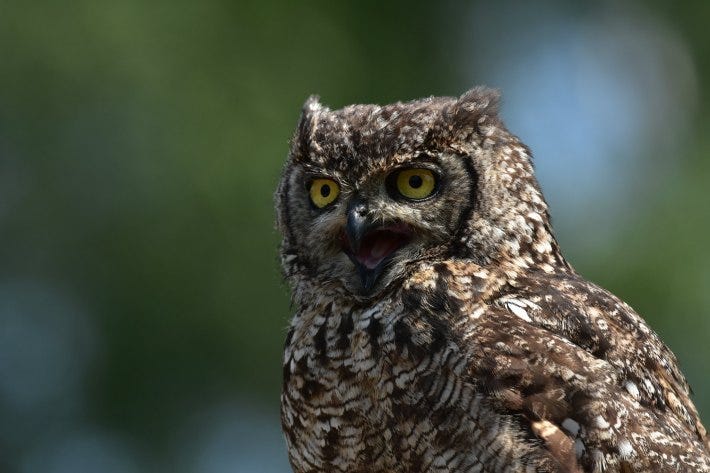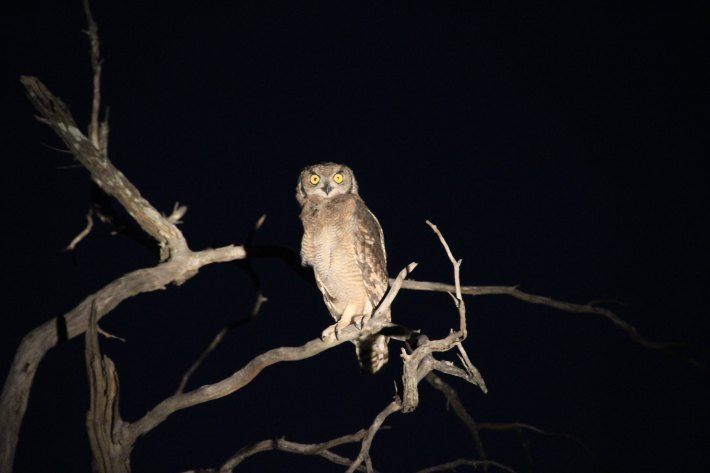
This week's Bird of the Week is a milestone because it is our very first owl. At some point, you are not a credible bird compendium unless you have brought owls into the picture, and now, here we go. Meet the spotted eagle-owl.
Here is the owl in the daytime. Looks pretty cute! Note its distinctive tufty ear-like feathers, which are purely for fashion and are not actually ears.

But, being an owl, the spotted eagle-owl is usually hardcore chilling during the day (the "experts" call this "roosting"). It is at its grandest when the sun goes down.
I'm going to take you on a little picture journey here. Unlike our last two birds, which are quite rare for humans to see in the wild, spotted eagle-owls are all over the place throughout Southern Africa, including in urban areas, so you can come into contact with them pretty easily. So let's say you're, I dunno, taking a wander through some field around Cape Town, and look at this!

Wow. Now come closer.

Wow. Now get even closer.

OMF and indeed G. The intimidating beauty here is off the charts (and, unlike so many birds, the male spotted eagle-owl and the female spotted eagle-owl both look basically the same, which is great). Owls are so cool. Can you even imagine being some little creature and THAT is suddenly coming after you?
Or maybe you will hear the owl. Here's how the South African National Biodiversity Institute describes the call of the spotted eagle-owl, in admirably precise detail:
The call of the Spotted Eagle-Owls is a mellow hoot. The males usually give a double hoot, ‘hoo-hooooee’, which the female answers with a softer triple hoot, ‘hoo-hoo-hooee’. If you happen to be watching one while it is calling, you will see a white patch on its throat become briefly conspicuous at each hoot. They are most vocal in the months leading up to the breeding season, May to August. Owls call to find partners, to tell their partners where they are and to proclaim their territories.
Actually, there appear to be about 50 different ways to characterize the call of the spotted eagle-owl. One website describes it as "Hooo hooopoooo" for males and "Hooo hoo hooo" for females; another has it as "wuhuhu-whooh."
Here is a video of some spotted eagle-owls calling. I'm pretty sure you get both the female and the male calls in this one. You decide what it sounds like!
Spotted eagle-owls also mate for life, and they are nice to each other. From the website Animalia:
Spotted eagle-owls are generally solitary birds. During the day they roost in trees, rock crevices, caves, under bushes, or sometimes even in abandoned burrows. Pairs may sometimes roost together, engaging in mutual preening. Spotted eagle-owls are nocturnal hunters; they usually hunt by swooping down toward the prey and either catch it directly or pursue it on foot. An adult pair is typically very aggressive in defense of its hunting territory. When the female cannot leave the nest the male will hunt and bring her food. Sometimes, even in conditions verging on starvation, he will tear the head off a mouse, but bring the body for the female to feed to the young, or to eat herself if the eggs have not yet hatched.
Sharing a mouse corpse so that everyone can eat??? That's love, people.
OK, one last pic: the owl in flight.

Yep. Thanks, spotted eagle-owl, for all that you do.
A reminder: you can check out our complete Bird of the Week list here, and get in touch with your bird suggestions at hello@discourseblog.com.











